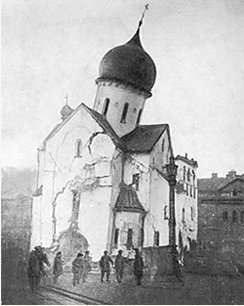Published in the book Leaves of Morya’s Garden. Book 1: The Call. 1924. 2nd edition. Мoscow: ICR; Master-Bank, 2003.
L. Shaposhnikova. The Philosophy of Cosmic Reality
To understand scientifically is to place the phenomenon in the framework of the scientific reality of the Cosmos.
V. Vernadsky
The best intellects turn to the factors of the interaction of the Cosmic Powers with the fates of earthly peoples.
N. Roerich
At the end of the 19th – beginning of the 20th century, the Spiritual Revolution started in Russia, which marked the beginning of the culture and philosophic thought of the Silver Age. The Silver Age brought dazzling flashes of heyday in art, literature, and philosophy, as well as the conception of new scientific thought. Unfortunately, the Spiritual Revolution, which gave to Russia so much on the whole, did not get the honor of being mentioned in studies on the history and culture of Russia. This was due to various historical circumstances that had formed in Russia by the beginning of the 20th century. The primary circumstance was the fact that the Spiritual Revolution coincided to a certain extent with the social revolution that took place in 1917 and became known as the October Revolution. And then, the great opposition of the two revolutions started, which resulted first in the Spiritual Revolution slowing down, and then in its complete fading. However, the latter, which was based in the energetics of the spirit and culture of man, could not completely disappear from the country’s historical arena, and, beyond doubt, carried in itself the potential for renaissance. Relying on intransient values related to the creative activity of man, the Spiritual Revolution was programmed for a long duration, and its course could not be interrupted completely. Unlike the social revolution, the Spiritual Revolution is conditioned by and is related to the spiritual and energetic processes taking place in man himself.
 | |
| The Destruction of the Church
of St. Nicholas, Archbishop Mir Likiyskih, Bargradsky metochion . St. Petersburg. 1932 |
The social revolution, in contrast, was only preoccupied with the external part of the human being, bringing to the foreground the issues of class struggle, economic benefit for oppressed classes, and the transfer of power from dominating classes to the oppressed. The world outlook platform of the Russian social revolution was the sociological world perception of the 19th century, at the basis of which lay the social and economic doctrine of major German scientist Karl Marx. This doctrine created the foundations for the Russian social revolution, an ideology that received the name of Marxism-Leninism. If the range of the social revolution was limited to the earthly framework, the Spiritual Revolution spread its wings into the Cosmos, interacting with it and unifying the earthly and the heavenly into a single whole. It lay the bases for the cosmic reorientation of the most important forms of cognition, such as philosophy, science, and art.
The 20th century’s complicated realm of cognition
By the beginning of the 20th century, two trends had formed in gnoseology: the scientific and the extra-scientific. The scientific, or empirical, method of cognition was based on mechanistic materialism, in which experiment was the main instrument of cognition.
The so-called extra-scientific method of cognition dealt with the energetics of the inner world of man, his abilities appearing on the basis of creation by the energetics.
Each of these systems had its own history, its interactions with the phenomenon “spirit – matter,” its contacts with the opposite system, its results in the cognition of the surrounding world.
<...>
The separation of the scientific and extra-scientific (or super-scientific) systems of cognition was as fruitless as the separation of spirit from matter, even if conditional. By the beginning of the 20th century, such separation, if not completely obstructing the development of science, then, in any case, closed the way to the correct comprehension of the discovered phenomena.
|
|
||
|
||